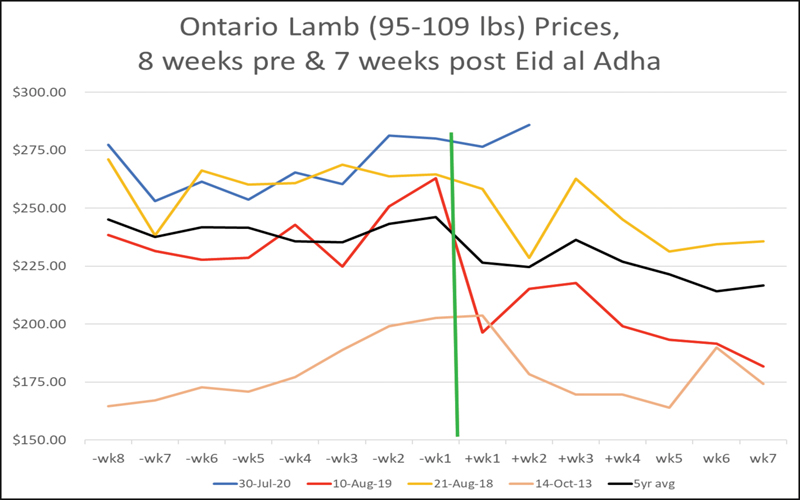Source: Ontario Sheep Farmers Note: The graph shows prices for the 8 weeks leading up to Eid al Adha and the 7 weeks following. The green vertical bar denotes the week of the celebration.
by Colleen Acres
AgriNews Contributor
OSGOODE – Sheep and lamb production has been in my family history for over a century, but every year and every day we learn something new about these small ruminants.
Demand for lamb is strong and domestically we only fill about 45 per cent of what the marketplace demands. This has resulted in favourable prices and a strong interest in sheep farming in Canada. New producers and existing producers are expanding to help fill the demand domestically instead of us relying on imported product.
This is one of the reasons why I was approached to be a regular contributor to the AgriNews paper – so that the relatively small sheep industry could contribute to this paper and (hopefully) provide some practical advice for those in or considering to join the industry. So we thought we would start out with the markets and move into other production matters in subsequent editions.
Historically lamb was a seasonal market with demand peaking for Easter and Christmas celebrations. Lamb is now in demand year round and while there are different cultural preferences which dictate the size and type of lamb that is in demand, there truly is a market for every lamb and sheep that is produced. One of the best educational moves for a producer (or one considering it) is to spend a day at the local livestock auction learning about who is buying, what they are looking for and when they need it. The end of July was the Eid al Adha Muslim celebration and it is a huge demand period for lambs 90 lbs +. The celebration moves forward every year so in the not too distant future Easter and Eid will be at the same time, resulting in a strong price period followed by a traditional tapering off period.
Figuring out the market and when you want to market lambs, means you need to figure out when you will breed your sheep, what breeds you will choose, how you will raise them (grass fed vs grain fed). The gestation period for sheep is approximately 147 days and most sheep will breed naturally September – March. Breeding outside of those months requires selection of breeds that will breed out of season naturally or use of hormone therapy to induce estrus or diligent use of a lighting system to mimic seasons (called photoperiod). So deciding on your marketing plan will really help in planning all the other pieces of the puzzle.
Sheep will breed at 6 – 7 months of age so it is possible for a “lamb” to become a mother by her first birthday. Many breeders do not recommend this practice, however, and encourage waiting until they are 14-24 months for their first lambing. Lambs grow quickly and many producers wean them at 60 – 70 days of age to allow ewes a rest period before rebreeding and to take full advantage of lambs growth potential. Some of the terminal breeds will weigh 50-60 lbs at 60 days of age and if your market is for light lambs, they can be marketed shortly after weaning or fed out for a period to reach heavier weights. The maximum weight for lambs is 120 lbs in the Canadian marketplace, Americans market heavier lambs into 150-160 lbs.As you can see there is no one way for a lamb producer to farm sheep. It keeps producers learning, changing and managing their operations with an eye on what the marketplace dictates and awareness that there are lots of opportunity available.













